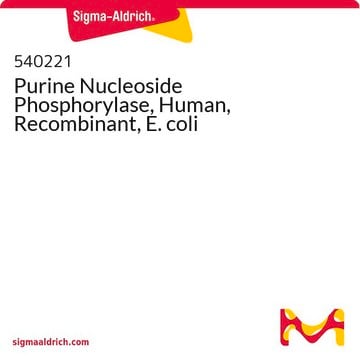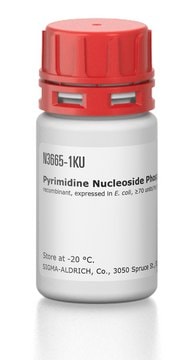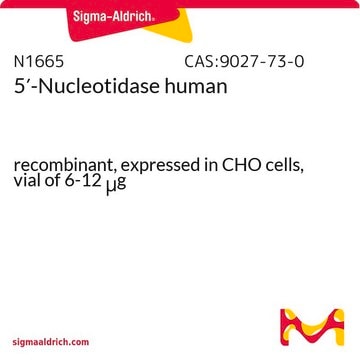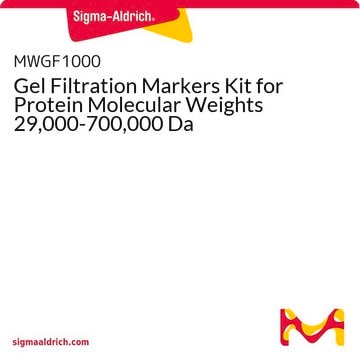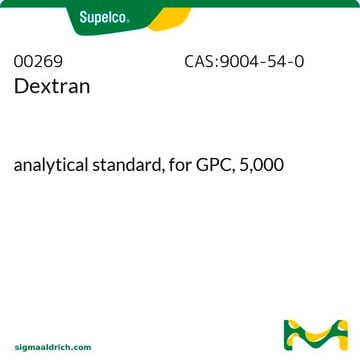Recommended Products
recombinant
expressed in E. coli
form
liquid
specific activity
≥1300 U/mL
relevant disease(s)
cancer
storage temp.
−20°C
Looking for similar products? Visit Product Comparison Guide
Application
Pyrimidine nucleoside phosphorylase (PyNPase) may be used as a marker to predict the malignant potential of breast cancer, especially lymph node metastasis. PyNPase is used to study breast cancer, specifically its role in angiogenesis.
Biochem/physiol Actions
Pyrimidine nucleoside phosphorylase (PyNPase) is a glycosyltransferase that catalyzes the conversion of pyrimidine nucleoside and phosphate to a pyrimidine base and α-D-ribose 1-phosphate. PyNPase plays a significant role in breast cancer angiogenesis.
Unit Definition
One unit will convert 1 μmole each of thymidine and phosphate to thymine and 2-deoxyribose 1-phosphate per minute at pH 7.4 and 25°C
Signal Word
Danger
Hazard Statements
Precautionary Statements
Hazard Classifications
Resp. Sens. 1
Storage Class Code
12 - Non Combustible Liquids
WGK
WGK 1
Flash Point(F)
Not applicable
Flash Point(C)
Not applicable
Certificates of Analysis (COA)
Search for Certificates of Analysis (COA) by entering the products Lot/Batch Number. Lot and Batch Numbers can be found on a product’s label following the words ‘Lot’ or ‘Batch’.
Already Own This Product?
Find documentation for the products that you have recently purchased in the Document Library.
K Mimori et al.
Annals of oncology : official journal of the European Society for Medical Oncology, 10(1), 111-113 (1999-03-17)
The clinical significance of pyrimidine nucleoside phosphorylase (PyNPase) activity in breast carcinomas has never been determined. In 41 cases of breast carcinoma, the enzyme activity of PyNPase was determined by the high performance liquid chromatography (HPLC) assay and its value
M J Pugmire et al.
Structure (London, England : 1993), 6(11), 1467-1479 (1998-11-18)
Pyrimidine nucleoside phosphorylase (PYNP) catalyzes the reversible phosphorolysis of pyrimidines in the nucleotide synthesis salvage pathway. In lower organisms (e.g. Bacillus stearothermophilus) PYNP accepts both thymidine and uridine, whereas in mammalian and other higher organisms it is specific for thymidine
T Hamamoto et al.
Bioscience, biotechnology, and biochemistry, 60(7), 1179-1180 (1996-07-01)
The purine nucleoside phosphorylase (Pu-NPase) and the pyrimidine nucleoside phosphorylase (Py-NPase) have been purified from Bacillus stearothermophilus TH 6-2. The Pu-NPase is a trimer of 30-kDa subunits and the Py-NPase is a dimer of 46-kDa subunits. The isoelectric points of
K Okuyama et al.
Bioscience, biotechnology, and biochemistry, 60(10), 1655-1659 (1996-10-01)
The pyrimidine nucleoside phosphorylase (Py-NPase) of Bacillus stearothermophilus TH 6-2 is a dimer of 46-kDa subunits and catalyzes the reversible phosphorolysis of uridine and thymidine. The gene encoding this pyrimidine nucleoside phosphorylase (pyn gene) has been cloned and sequenced from
Purification and comparative properties of a pyrimidine nucleoside phosphorylase from Bacillus stearothermophilus.
P P Saunders et al.
The Journal of biological chemistry, 244(13), 3691-3697 (1969-07-10)
Our team of scientists has experience in all areas of research including Life Science, Material Science, Chemical Synthesis, Chromatography, Analytical and many others.
Contact Technical Service
